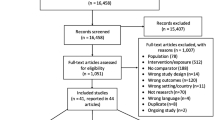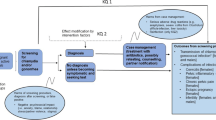Abstract
BACKGROUND: Because sexually transmitted chlamydial infections are common among young women, it is critical that providers screen and manage these infections appropriately.
OBJECTIVE: To assess the Chlamydia care practices of California primary care physicians and nurse practitioners.
DESIGN: Cross-sectional, self-report mail survey.
PARTICIPANTS: A stratified random sample of primary care physicians and a convenience sample of primary care nurse practitioners in California.
MEASUREMENTS AND MAIN RESULTS: Survey content included 5 topic areas: sexual history taking, management of cervicitis, management of a nonpregnant Chlamydia-infected patient, availability of on-site STD services, and Chlamydia screening practices and attitudes. Main outcome measure was the reported frequency of Chlamydia screening of sexually active women age 25 and younger. Respondents included 708 physicians (49% response rate) and 895 nurse practitioners (63% response rate). Nearly half of physicians (47%, 95% confidence interval [CI], 42% to 51%) and a majority of nurse practitioners (79%, 95% CI, 77% to 82%) reported routine Chlamydia screening of women under age 20; similar proportions reported routinely screening women aged 20 to 25 years. Independent predictors of screening among physicians were adolescent medicine specialty, female gender, practicing in a nonprivate setting, and having a higher volume of female patients. Additional findings included the overscreening of women over age 25 by nurse practitioners and the shared concern among providers that Chlamydia screening may not be reimbursed.
CONCLUSIONS: The Chlamydia care practices of many California primary care providers are inconsistent with current guidelines. Targeted provider education and improved reimbursements are potential strategies for improvement.
Similar content being viewed by others
References
Centers for Disease Control and Prevention. Sexually transmitted diseases treatment guidelines 2002. MMWR. 2002;51:1–80.
Hillis SD, Owens LM, Marchbanks PA, Amsterdam LF, MacKenzie WR. Recurrent chlamydial infections increase the risks of hospitalization for ectopic pregnancy and pelvic inflammatory disease. Am J Obstet Gynecol. 1997;176:103–7.
Stamm WE. Chlamydia trachomatis infections of the adult. In: Holmes KK, Sparling PF, Mardh P-A, et al., eds. Sexually Transmitted Diseases. 3rd ed. New York, NY: McGraw Hill; 1999:407–22.
Scholes D, Stergachis A, Heidrich FE, Andrilla H, Holmes KK, Stamm WE. Prevention of pelvic inflammatory disease by screening for cervical chlamydial infection. N Engl J Med. 1996;334:1362–6.
Bachmann LH, Macaluso M, Hook EW. Demonstration of declining community prevalence of Chlamydia trachomatis infection using sentinel surveillance. Sex Transm Dis. 2003;30:20–4.
U.S. Preventive Services Task Force. Screening for chlmaydial infection: Recommendation and rationale. Am J Prev Med. 2001;20(3 suppl):90–4.
St Lawrence JS, Montano DE, Kasprzyk D, Phillips WR, Armstrong K, Leichliter JS. STD screening, testing, case reporting, and clinical and partner notification practices: a national survey of US physicians. Am J Public Health. 2002;92:1784–8.
National Committee for Quality Assurance. State of Health Care Quality Report, 2003: Chlamydia Screening. Available at: http://www.ncqa.org/sohc2003/chlamydia_screening.htm#Results%20and%20Analysis. Accessed April 14, 2004.
Ewing GB, Selassie AW, Lopez CH, McCutcheon EP. Self-report of delivery of clinical preventive services by U.S. physicians. Comparing specialty, gender, age, setting of practice, and area of practice. Am J Prev Med. 1999;17:62–72.
Millstein SG, Igra V, Gans J. Delivery of STD/HIV preventive services to adolescents by primary care physicians. J Adolesc Health. 1996;19:249–57.
Ellen JM, Franzgrote M, Irwin CE, Millstein SG. Primary care physicians’ screening of adolescent patients: a survey of California physicians. J Adolesc Health. 1998;22:433–8.
Halpern-Felsher BL, Ozer EM, Millstein SG, et al. Preventive services in a health maintenance organization: how well do pediatricians screen and educate adolescent patients? Arch Pediatr Adolesc Med. 2000;154:173–9.
Lafferty WE, Downey L, Shields AW, Holan CM, Lind A. Adolescent enrollees in Medicaid managed care: the provision of well care and sexual health assessment. J Adolesc Health. 2001;28:497–508.
Burstein GR, Lowry R, Klein JD, Santelli JS. Missed opportunities for sexually transmitted diseases, human immunodeficiency virus, and pregnancy prevention services during adolescent health supervision visites. Pediatrics. 2003;111(5 Part 1):996–1001.
Magid DJ, Stiffman M, Anderson LA, Irwin K, Lyons EE. Adherence to CDC STD guideline recommendations for the treatment of Chlamydia trachomatis infection in two managed care organizations. Sex Transm Dis. 2003;30:30–2.
California Chlamydia Action Coalition. California Sexually Transmitted Disease Initiatives Home Page. Available at: http://www.ucsf.edu/castd/. Accessed April 13, 2004.
Brindis CD, Llewelyn L, Marie K, Blum M, Biggs A, Maternowska C. Meeting the reproductive health care needs of adolescents: California’s family planning access, care, and treatment program. J Adolesc Health. 2003;32(6 suppl):79–90.
California Family Planning A, Care and Treatment (Family PACT) Program. Family PACT Home Page. Available at: http://www.dhs.ca.gov/pcfh/ofp/Programs/FamPACT/default.htm. Accessed April 14, 2004.
SAS. Statistical software [computer program]. Version 8.2. Cary, NC: SAS Institute; 1999–2001.
STATA. Statistics/Data Analysis [computer program]. Version 7.0. College Station, Tex: STATA; 1984–2002.
U.S. Preventive Services Task Force. Counseling to Prevent HIV Infection and Other Sexually Transmitted Diseases. Guide to Clinical Preventive Services. Baltmore, Md: Williams & Wilkins; 1996:723–37.
Boekeloo BO, Marx ES, Kral AH, Coughlin SC, Bowman M, Rabin DL. Frequency and thoroughness of STD/HIV risk assessment by physicians in a high-risk metropolitan area. Am J Public Health. 1991;81:1645–8.
Torkko KC, Gershman K, Crane LA, Hamman R, Baron A. Testing for Chlamydia and sexual history taking in adolescent females: results from a statewide survey of Colorado primary care providers. Pediatrics. 2000;106:E32.
California Department of Health Services. Sexually Transmitted Diseases in California, 2002. Sacramento, Calif: California Department of Health Services; 2004.
Grimes DA, Schulz KF. Uses and abuses of screening tests. Lancet. 2002;359:881–4.
California Chlamydia Action Coalition. Chlamydia Screening and Treatment Practice Guidelines (First Release). Berkeley, Calif: California Chlamydia Action Coalition; December 2001.
California Chlamydia Action Coalition. Chlamydia Screening and Treatment Practice Guidelines. Berkeley, Calif: California Chlamydia Action Coalition; November 2002.
Author information
Authors and Affiliations
Corresponding author
Additional information
The authors have no conflicts of interest to declare for this article or this research.
This project was supported in part by the Centers for Disease Control and Prevention (Comprehensive STD Prevention Systems and Infertility Prevention Project Grant #H25/CCH904362), the California STD/HIV Prevention Training Center (Grant #R30/CCR91546707), and the California Department of Health Services.
Rights and permissions
About this article
Cite this article
Guerry, S.L., Bauer, H.M., Packel, L. et al. Chlamydia screening and management practices of primary care physicians and nurse practitioners in California. J GEN INTERN MED 20, 1102–1107 (2005). https://doi.org/10.1111/j.1525-1497.2005.00240.x
Received:
Revised:
Accepted:
Issue Date:
DOI: https://doi.org/10.1111/j.1525-1497.2005.00240.x




